Travels Through Pakistan – An Epic Travellers Tale
It sounds dramatic I know, but I arrived in Pakistan for the first time under a hail of falling rocks, lightning, thunder and torrential rain. It was September 1992 and I had just left the Chinese border town of Tashkurgan and was travelling by bus through no-man’s-land to the Pakistani border at Sost (also known as Sust) in Baltistan. An hour or so into the journey (no-man’s-land between the two countries is vast) the heavens opened up and rocks of various sizes started flying down the mountainside onto the road in front and behind our bus. Eventually, everyone on the bus abandoned it (including the Chinese driver) and we ended up as a group walking and dodging our way to the small town of Sost. We arrived well after dark, ate some food and retired to bed, exhausted.
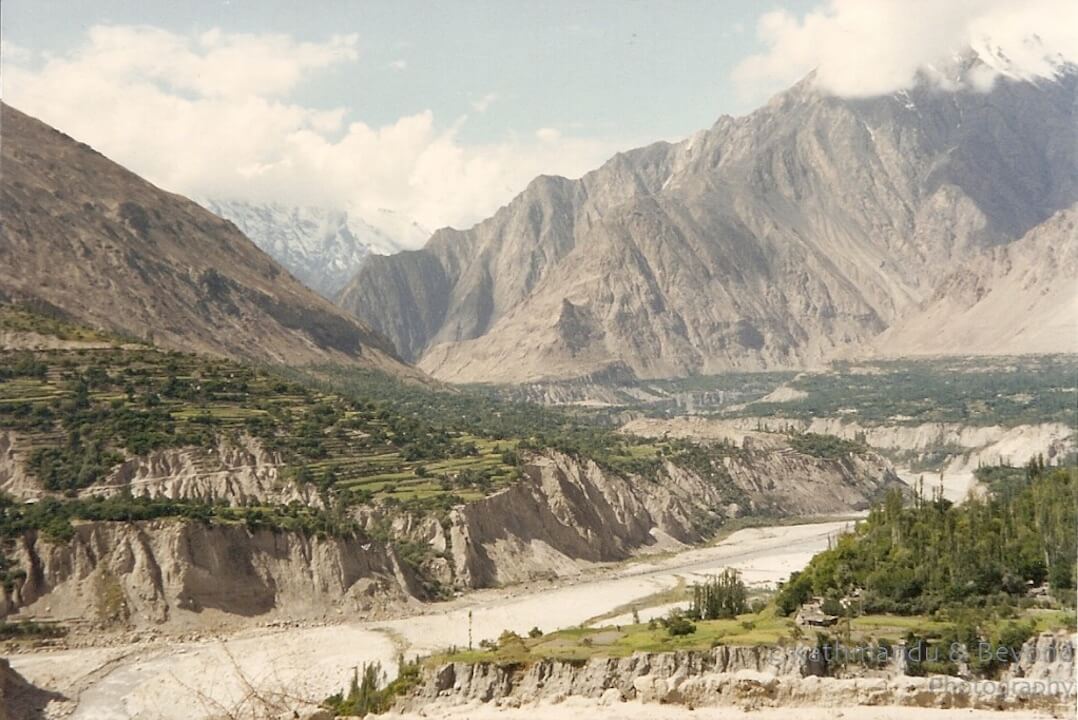 The Hunza Valley in 1992 photographed by Mark
The Hunza Valley in 1992 photographed by Mark
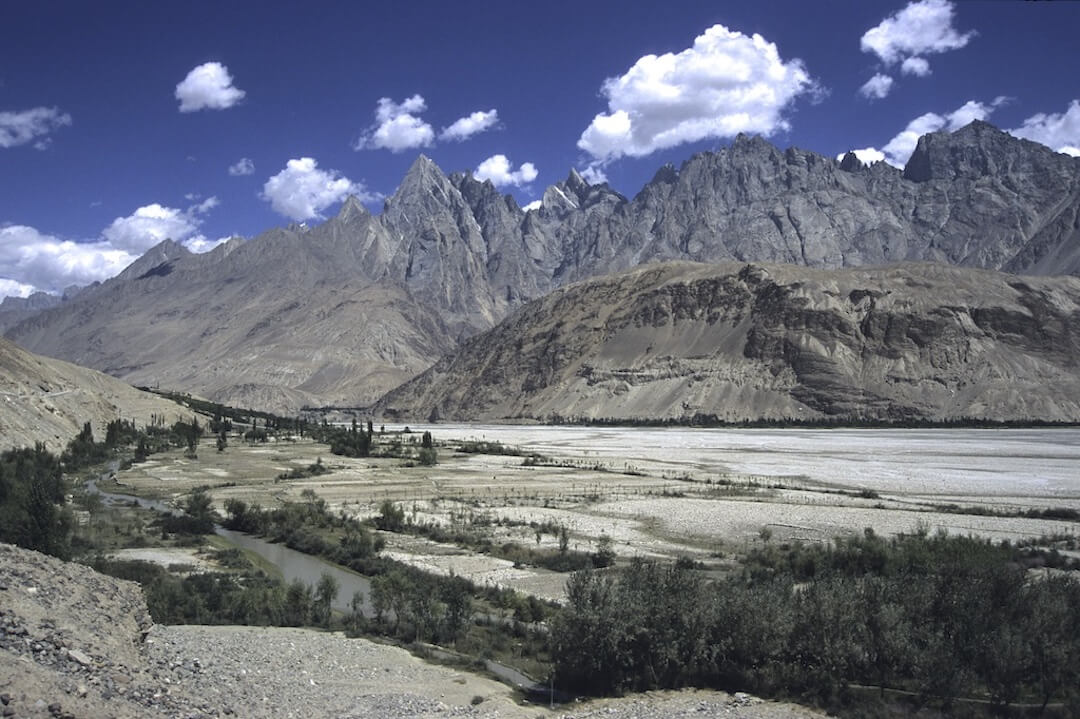 The Hunza Valley Pakistan in more recent times Image © Edwardje | Dreamstime.com
The Hunza Valley Pakistan in more recent times Image © Edwardje | Dreamstime.com
Interactive map of places visited during Mark’s 1992 travels through Pakistan
It was an unusual way to arrive in a country and it didn’t stop raining for days. In fact, and we didn’t find this out until we got to Gilgit, the torrential rains had caused the Indus River and its tributaries to swell so much that there was terrible flooding in Pakistan’s Punjab and Kashmir regions. Much later I discovered that more than 1,000 people died and thousands more were displaced as a result of the flooding that year.
Finally, it stopped raining and the fantastic scenery that had attracted me to northern Pakistan in the first place started to appear. It was time to assess our situation. Sost is connected to Gilgit, the administrative capital of Baltistan and largest town in the region, by way of the Karakoram Highway (KKH). However, we were told that in the aftermath of the storm the KKH was impassable for practically all types of vehicle. Large sections of it were either washed away or covered in landslide debris. Heading back to China wasn’t an option without a valid Chinese visa. Some had tried and were turned back at the border.
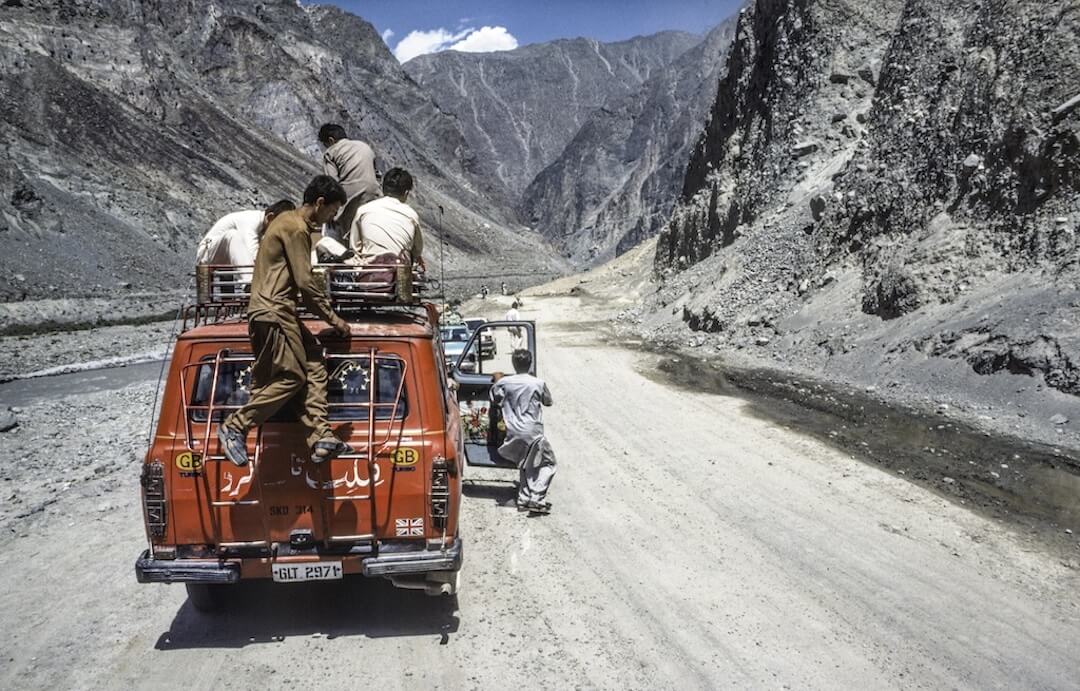 Car on Karakorum Highway after a landslide taken in more recent times Image © Meinzahn | Dreamstime.com
Car on Karakorum Highway after a landslide taken in more recent times Image © Meinzahn | Dreamstime.com
This left us with two options. We either sat in out in Sost and waited for the National Highways of Pakistan (who maintain the KKH) to clear the road as far as Gilgit or we could start walking (and hitching where we could) in a southerly direction. The problem with the first option was the distance from Sost to Gilgit was 180km and although stretches of the road were OK (*), it was understandably going to take the maintenance guys a very long time to clear the entire route. The problem with the second option was the fact that the distance from Sost to Gilgit was 180km!
(*) All of our information was hearsay and rumours. We had nothing confirmed.
We stayed in situ for about another week. Reports about road improvement were not encouraging and ultimately, we knew we would have to walk and hitch if we were to get to Gilgit and beyond anytime soon. Food rations were also starting to get a bit tight. OK, I am exaggerating a little here. There was no shortage of dhal, chapattis and chai (sweet, milky tea) but the local store had run out of biscuits and chocolate bars so the situation was pretty serious to us. So, a bunch of us decided to head off the following morning. I didn’t sleep much the night before we left. We were safe in Sust and most of us (my girlfriend and I included) didn’t have the right gear for such an epic trip (*). We were all hoping we would be able to hitch lots of short stretches of the KKH and that the walking could be kept to a minimum.
(*) I only had Converse shoes and a crappy anorak that I had purchased in China.
We were a group of nine westerners plus four Pakistani men who also wanted to travel south (*). There was Sam, my girlfriend at the time, and me; Olly and Bernie, two very camp railway carriage attendants from Vienna; an elderly doctor and his wife who hailed from Liverpool in the UK; and an Australian man and his 15-year-old daughter. The daughter had learning difficulties and was an inspiration to us all. She was fun to be around and used to try and cuddle the Pakistanis in our group when they were preparing for prayers. They never got annoyed and never scolded her. Finally, there was Richard, a heavily accented Geordie (someone from the Tyneside region in the north-east of England) who had tried to go north to China and given up and was, therefore, heading south with our merry group.
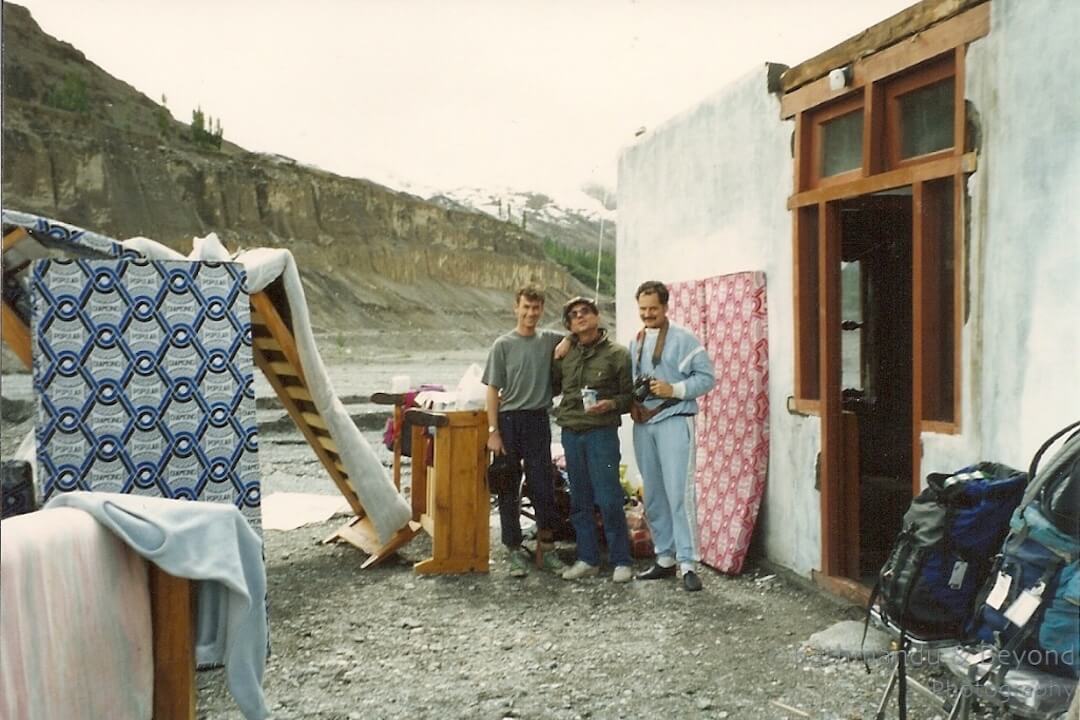 Mark, Olly and Bernie in Sost
Mark, Olly and Bernie in Sost
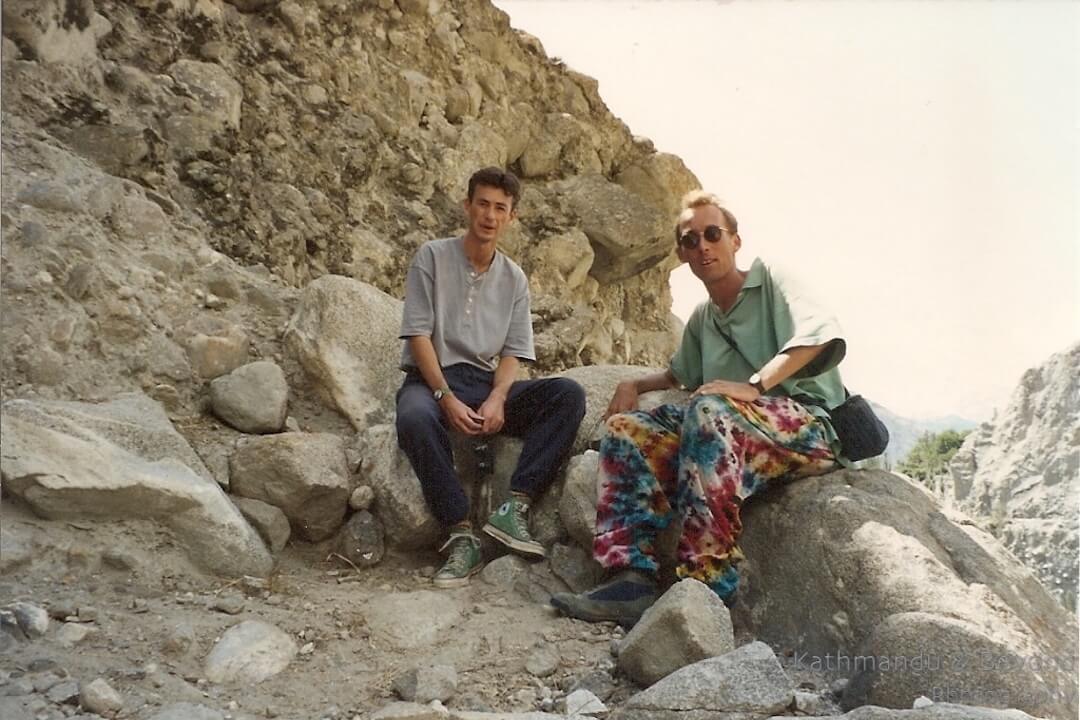 Mark and Richard Karakoram Highway somewhere between Sost and Gilgit
Mark and Richard Karakoram Highway somewhere between Sost and Gilgit
(*) Without the four Pakistanis we would have struggled. They quickly took on the role of unofficial guides (one at the front, one at the back etc) and were always on hand to help the less able members of the group. They could have got to Gilgit in half the time that we took I am sure but they stayed with us throughout the entire journey. They were true gentlemen and they never asked for anything in return. It brings a lump to my throat just writing about them.
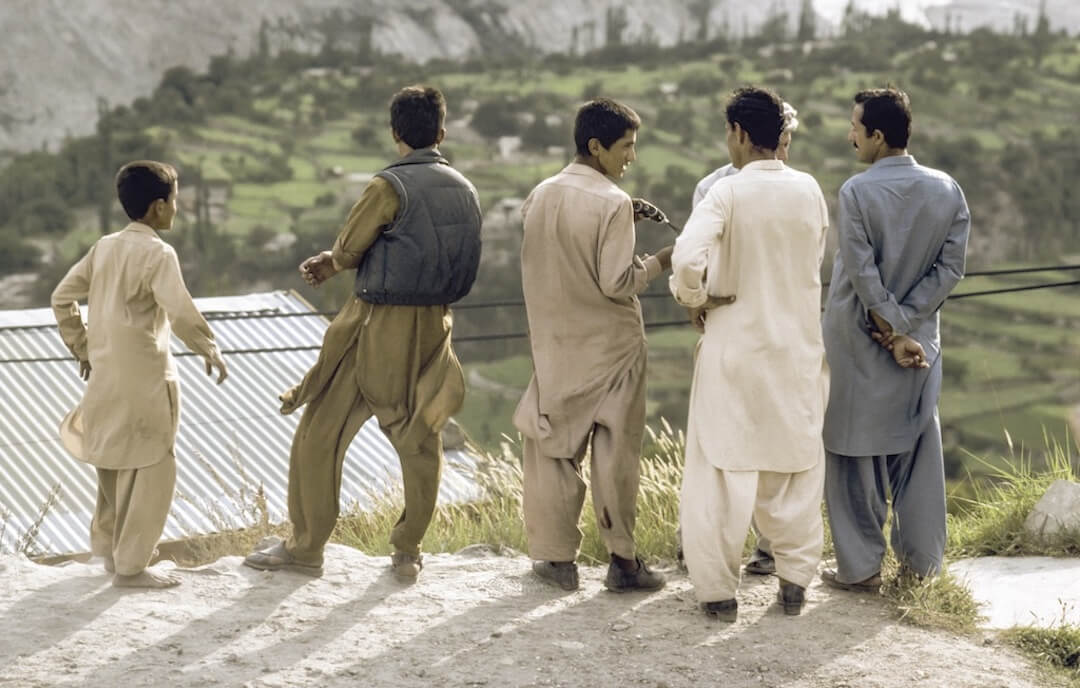 The Karakoram Highway in Pakistan Image © Meinzahn | Dreamstime.com
The Karakoram Highway in Pakistan Image © Meinzahn | Dreamstime.com
An hour after leaving Sost we had to cross the mother of all landslides and this ended up being the norm for the next couple of weeks. Thankfully though, there were plenty of stretches of clear road and entrepreneurial locals took full advantage of this. Charging way over the odds, they would ferry foreigners and locals alike from one bit of blocked road to the next, using tractors and trailers, trucks, minivans and beaten up old cars. The distance per journey varied from 2-3km up to 20km plus and even mules were offered on some of the shorter distances. As it turned out, I estimate that we probably only walked about a third of the 180km distance and managed to pay for rides for the rest of it. We also took our time, stopping at various towns and villages along the way, often for two or three days at a time. After all, these were the places we had come to northern Pakistan to see and without exception, the scenery along the way was stunning.
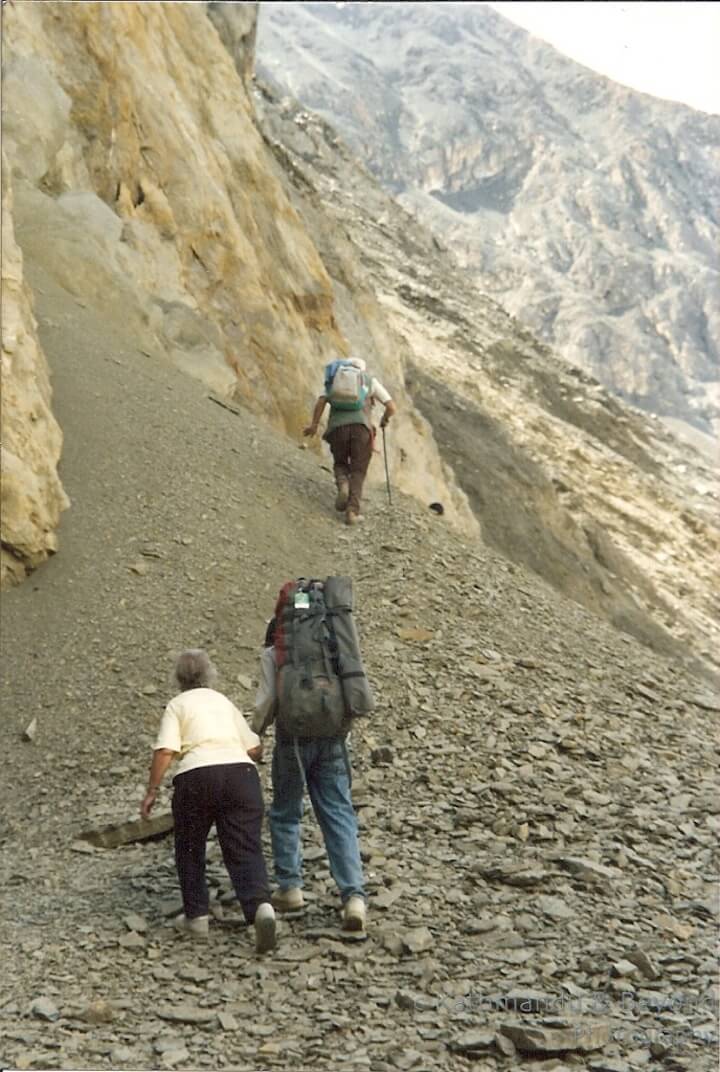
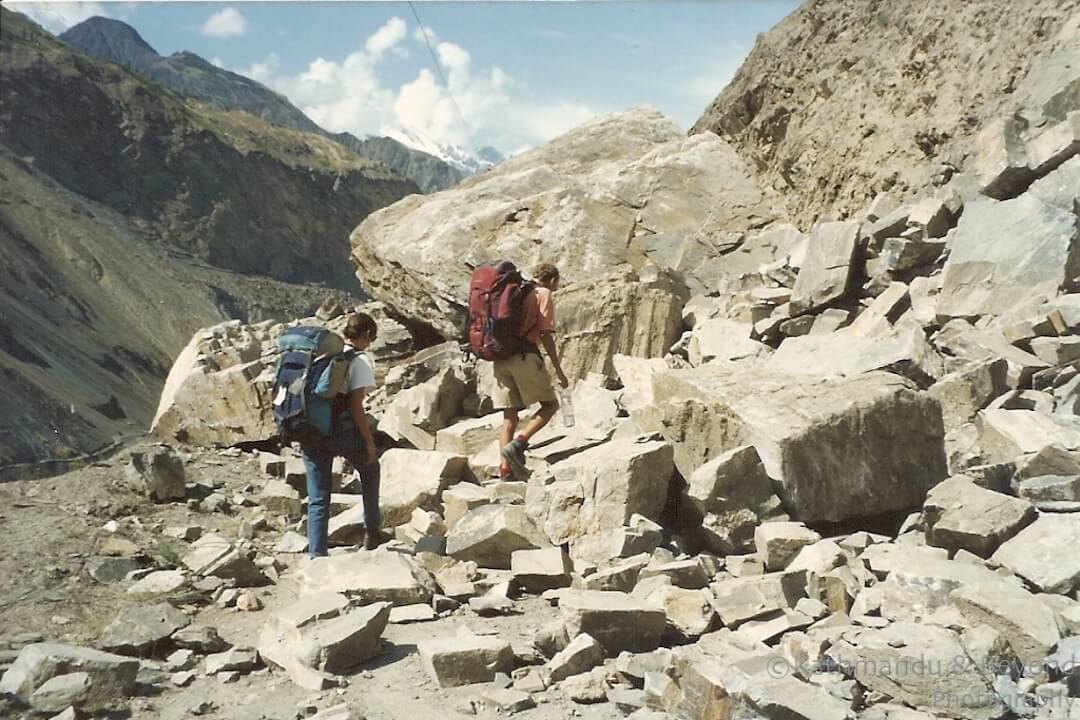
The doctor, his wife and one of our Pakistan ‘guides’ Karakoram Highway somewhere between Sost and Gilgit (left) and Sam and Richard Karakoram Highway somewhere between Sost and Gilgit (right)
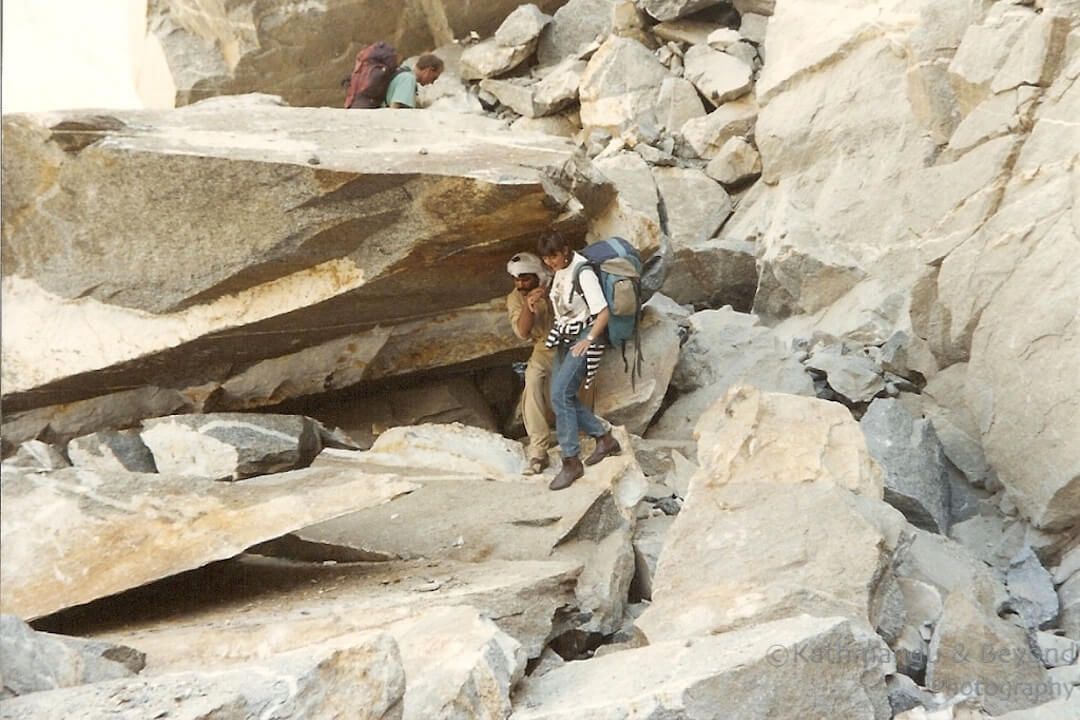
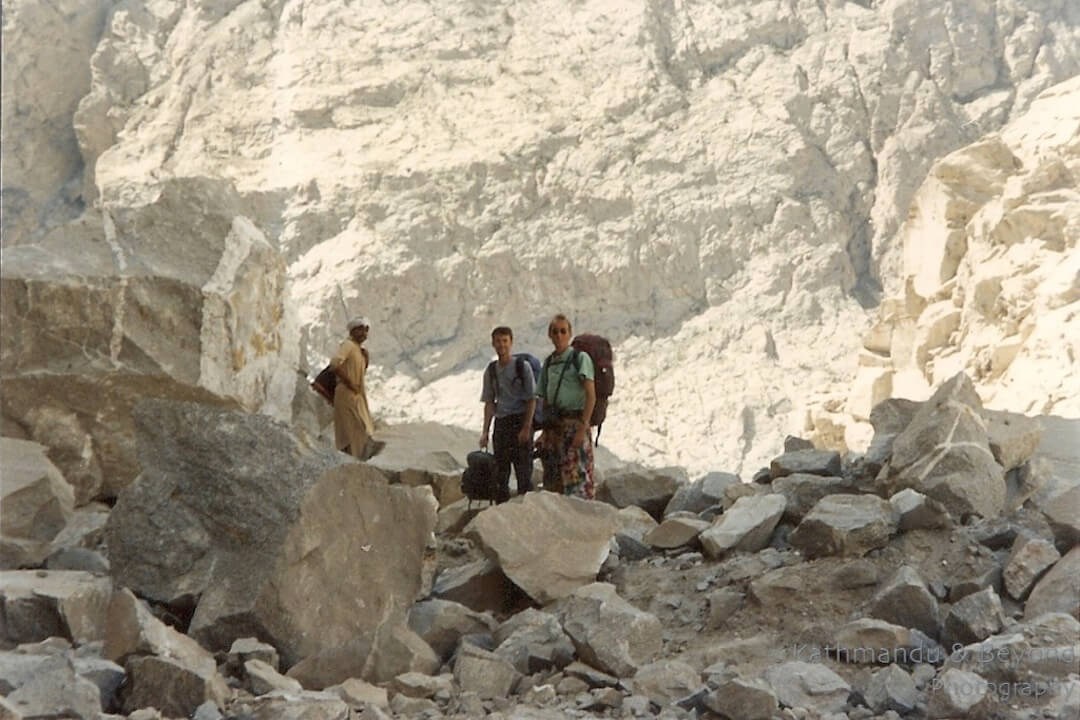
Sam and one of our Pakistan ‘guides’ Karakoram Highway somewhere between Sost and Gilgit (left) and Mark and Richard plus and one of our Pakistan ‘guides’ Karakoram Highway somewhere between Sost and Gilgit (right)
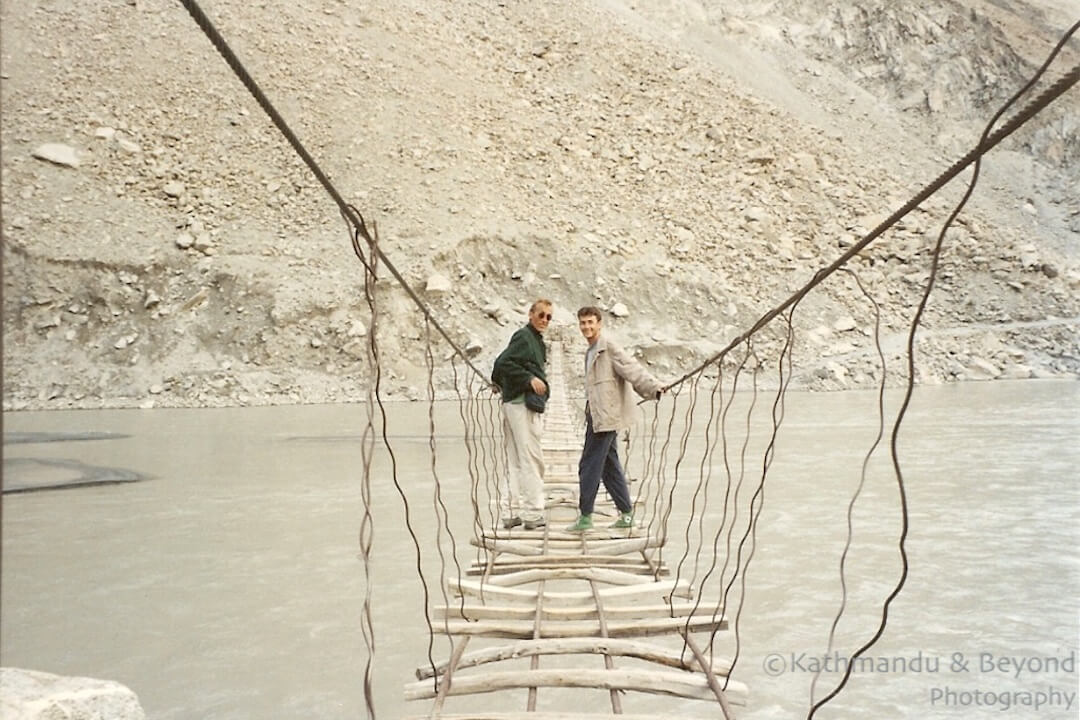
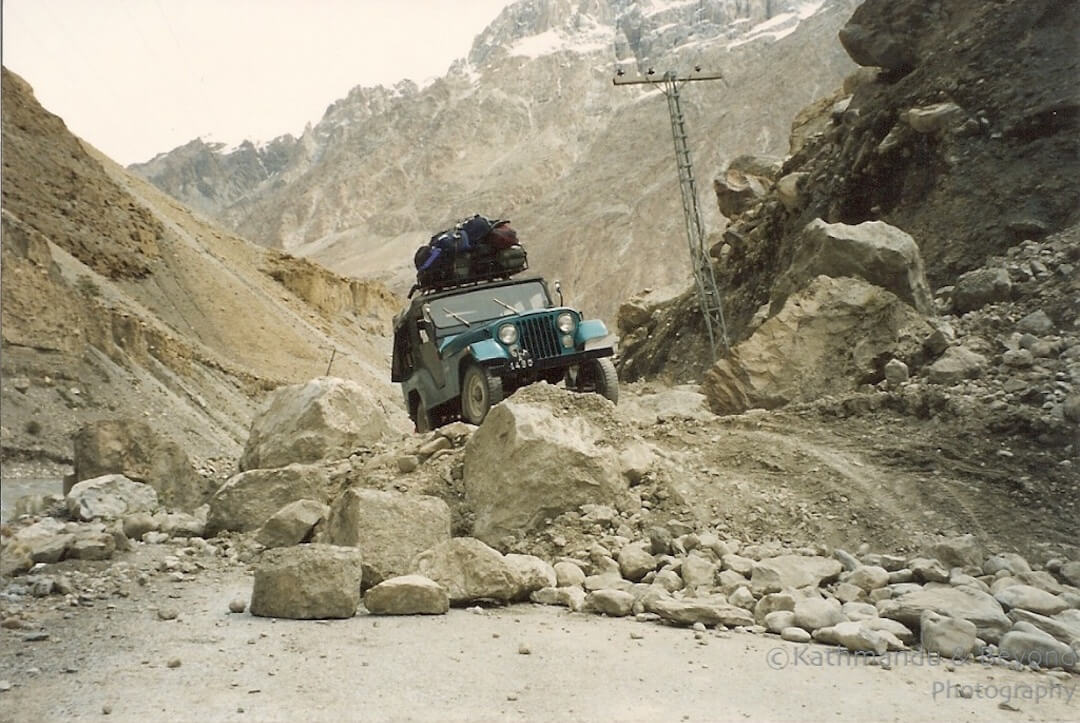
Mark and Richard crossing the Indus River (left) and Karakoram Highway in 1992 (right)
Looking back, it was a journey of a lifetime and there are many things about it that have stayed in my memory. They include celebrating the wedding anniversary of the doctor and his wife in Passu. They treated all of us to a slap-up meal in the best hotel in town. There was no booze (Pakistan is dry) but there was cake and none of us had eaten cake for ages – it was delicious. I also remember growing a moustache (my only one ever). I had a boil on my nose and it was too painful to shave underneath it – I looked stupid with a moustache. I remember the blond hair and blue eyes of the children in the Hunza Valley (*) and all the friendly locals we met along the way including Ali’s dad.
(*) The Hunzakuts or Hunza people are indigenous to Pakistan’s Hunza Valley. There are various reports suggesting that they may have a direct lineage to the soldiers of Alexander the Great’s army, who came to the region in the 4th century BC.
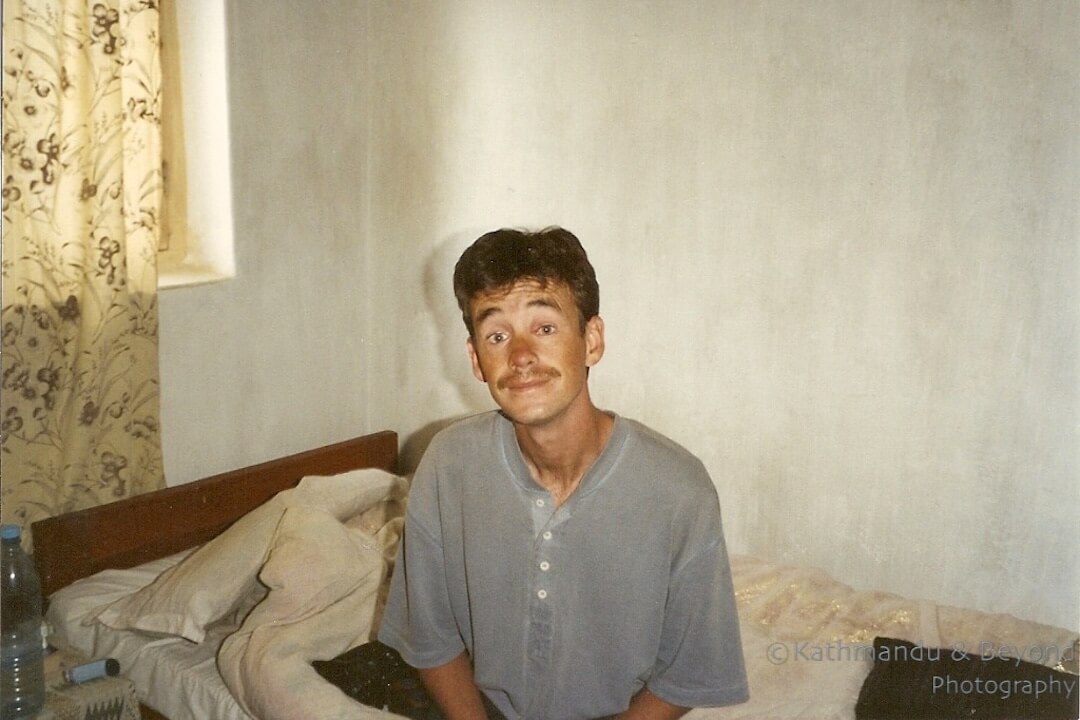 Mark with his one and only moustache in Hunza Valley
Mark with his one and only moustache in Hunza Valley
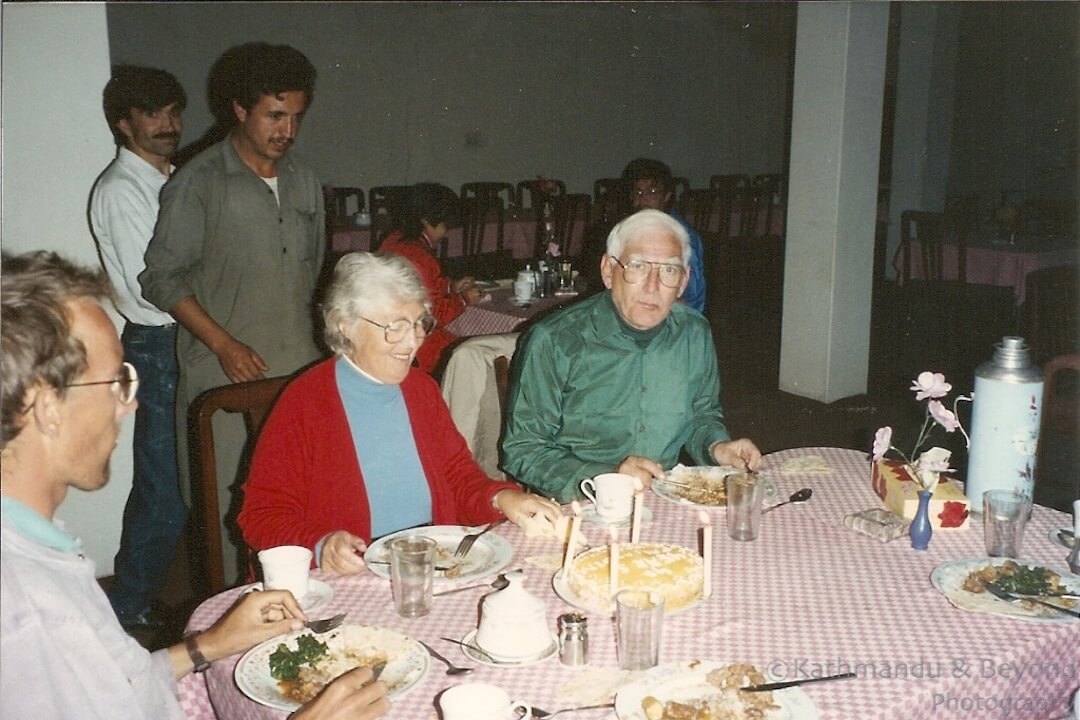 Wedding anniversary celebrations with the doctor and his wife in Passu
Wedding anniversary celebrations with the doctor and his wife in Passu
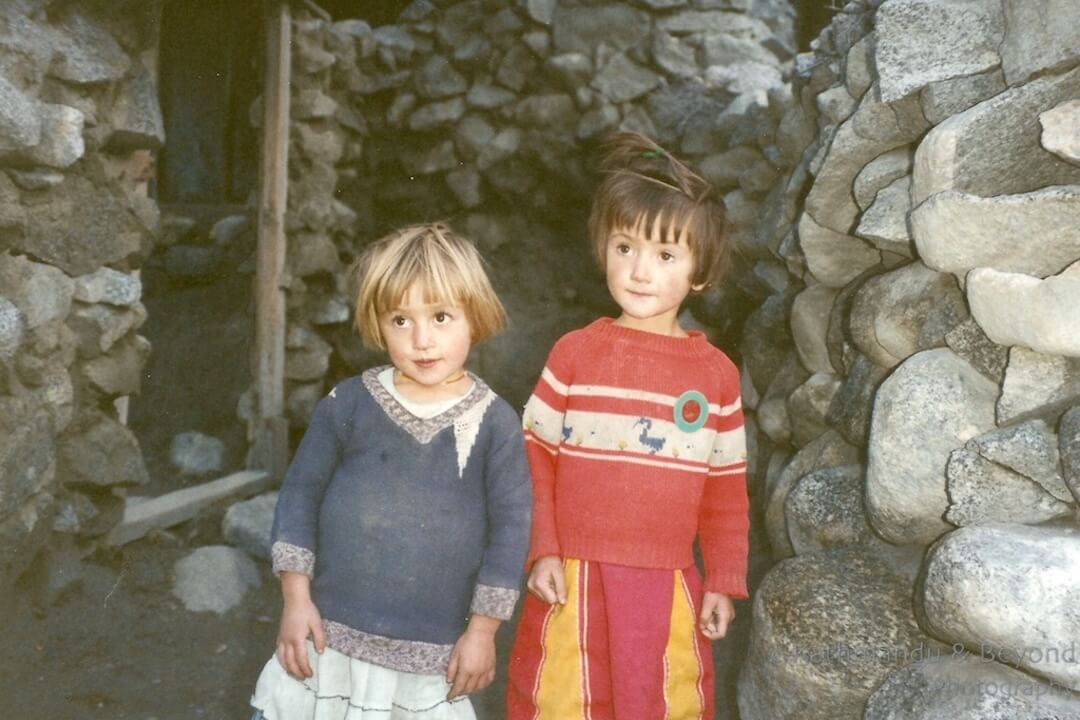 Hunza Valley in 1992
Hunza Valley in 1992
I recall lazy afternoons sitting outside local stores; drinking tea, eating biscuits and chewing the fat but most of all I remember the fuss and commotion caused when a helicopter belonging to the Aga Khan Foundation landed in a field near Gulmit. The pilots (both in Ray-Ban sunglasses – how cool!) were picking up an old lady who was pretty sick and transporting her to Gilgit so she could receive medical attention. We, of course, chanced our arm and asked for a ride to Gilgit as well. There were nine of us, it was never going to happen but the pilots did offer to get a handwritten message to the British Embassy in Islamabad. We took them up on this offer, handed one over and thought no more of it. About eight weeks later I phoned my parents back in the UK and they mentioned that they had received a telephone call (*) from the Home Office in London informing them that their son was safe and well, albeit somewhat stranded, in northern Pakistan. I recall their response was that they didn’t even know I was in Pakistan!
(*) The kind doctor from Liverpool also promised to contact my parents upon the return of him and his wife and he duly did so.
So remember people, there was communication before email and Facebook and although it was a tad slow, it worked just dandy!
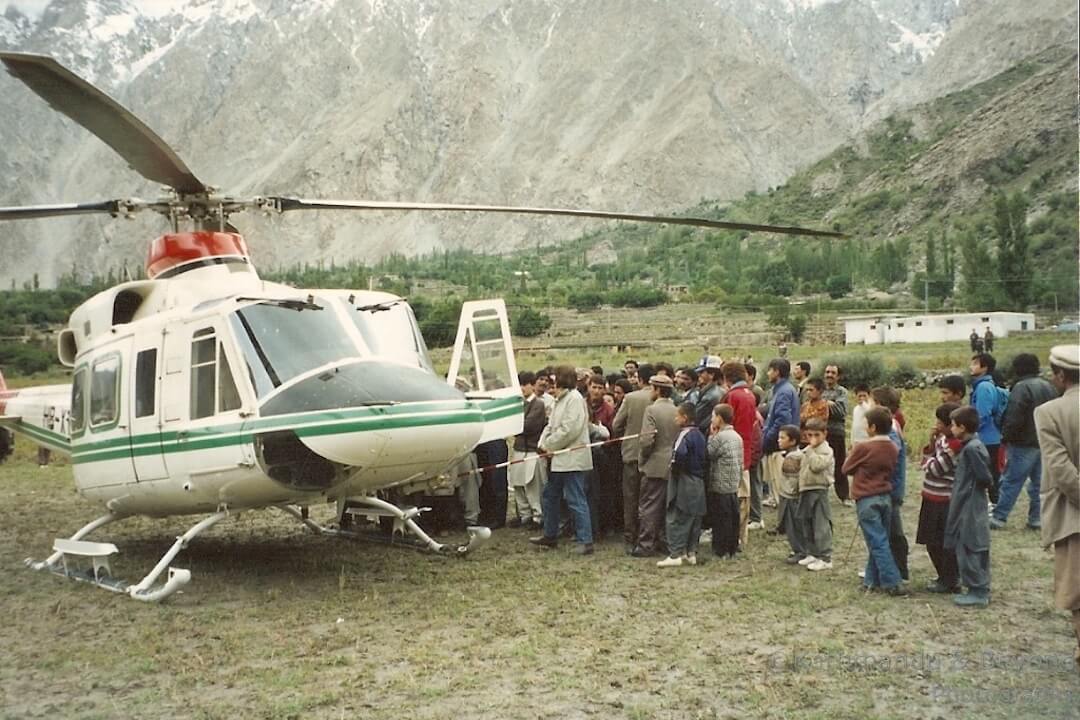 Big excitement as the Aga Khan’s helicopter lands in the Hunza Valley in 1992
Big excitement as the Aga Khan’s helicopter lands in the Hunza Valley in 1992
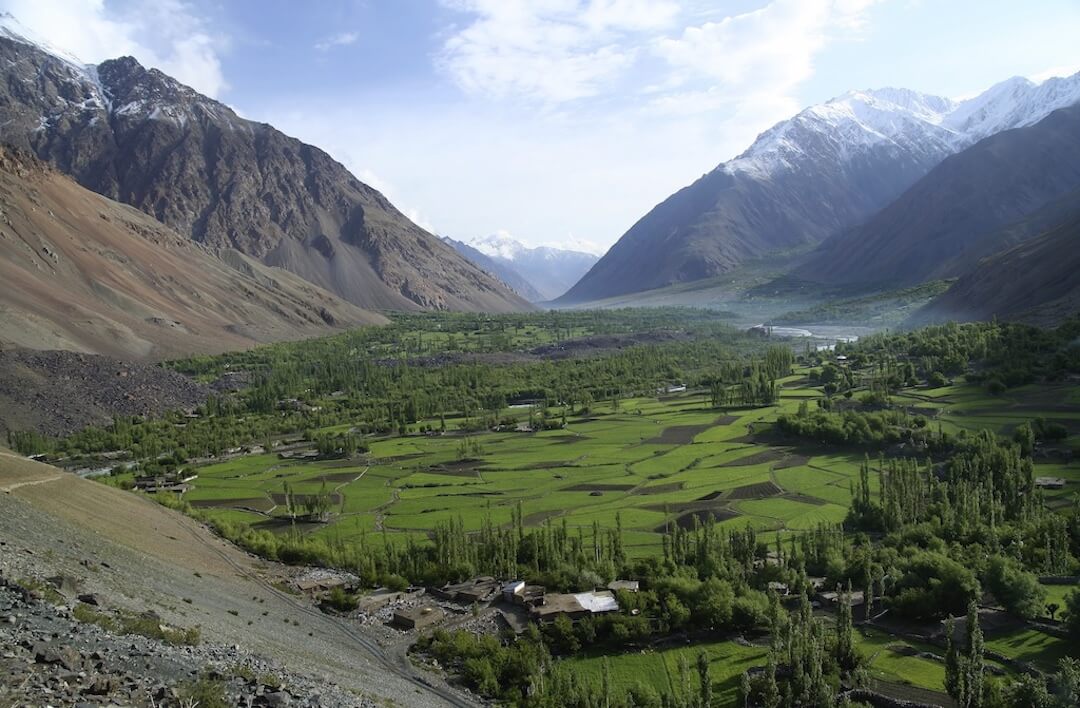 The Hunza Valley in Pakistan in more recent times Image © Paop | Dreamstime.com
The Hunza Valley in Pakistan in more recent times Image © Paop | Dreamstime.com

Enjoyed that. Brought back good memories, though when I took the route (1991 and in the opposite direction than you) there were no landslides that I recall other than one between Gilgit and Skardu. Glad I didn’t have to walk one third of the distance between Sust and Gilgit.
I like the ‘stache, too. You should grow it back, and then you’ll be ready to play Clouseau if the Pink Panther movies are ever revived.
I thought it would bring back memories for you. I recall you were there about the same time. We had no chance of getting to Skardu, that road from Gilgit was in even worse shape than the KKH. The mustache is never going to make an appearance again I am afraid!
Wow Mark, Pakistan has to offer much more. Do you plan to visit Pakistan again sometime soon?
We don’t have any exact plans at the moment as we are travelling in Europe but some day soon, that’s for sure!
My father and I were also stuck in Sost at the same time. We essentially did the same as you. We waited for a week or so and decided to walk and pay for rides to Gilgit. No guides and I was very sick from dysentery. We made it out alive though. I remember that my father preferred to walk on the outside of what was left of the road to avoid the still falling rock and soil. I took my chances on the inside as I didn’t like looking over the edge of some of the drop offs on such unstable ground. I have many photos of this adventure in a box in my basement.
Love reading about how travel used to be before the Internet. Something very special we won’t get back…
I know what you mean! It made travelling a bit more of an adventure but I don’t miss the wandering around for ages looking for a place to stay part of it!!
The Kalash are not descendants of Alexander the Great, whom wasn’t blonde and looked swarthy and looked dark skinned, I don’t know where this idea started but genetics has completely ruled out this idiotic made up myth and so has linguistics. Also the Kalash and Nuristani language is a linguistic isolate completely different from European languages hence the “Dardic family” identification of them, they have no memories or ties to Europe culturally, historically, or linguistic wise, and they don’t wear any attire or apparel or celebrate any rituals connected to Macedonian anyone.
My father and I were also stuck in Sost at the same time. We essentially did the same as you. We waited for a week or so and decided to walk and pay for rides to Gilgit. No guides and I was very sick from dysentery. We made it out alive though. I remember that my father preferred to walk on the outside of what was left of the road to avoid the still falling rock and soil. I took my chances on the inside as I didn’t like looking over the edge of some of the drop offs on such unstable ground. I have many photos of this adventure in a box in my basement.
Thank you for sharing your (more or less exactly the same) memories of your experience. I was the same as you, I couldn’t be too close to the edge so I also took my chances with falling rocks! I wonder if we ever bumped into one another? We met many people doing the same thing and there was great camaraderie even though it was an arduous journey to undertake.
Hey, what a wonderful story! I’ve had the pleasure of visiting these places several times myself. I hail from lower Hunza. In September 1992, I was just one year old—perhaps fast asleep while you passed by my village. Now, I work with the Aga Khan Foundation. 🙂 Helicopters have changed now. The one in the picture is Bell 212, now we’ve Agusta 139.
While I appreciate all the details you’ve shared about your journey, a particular aspect of your love story caught my attention. You mentioned “Sam, my girlfriend at the time.” I’m curious—Did she become your wife, or did you part ways? I’m intrigued to hear the continuation of your story.
Hi Ahmed, what a lovely coincidence that you now work for the Aga Khan Foundation. I like the idea of passing your village on our way south – maybe your family was one of many who gave us cups of tea, snacks and other hospitality along the way . Regarding my girlfriend at the time, we parted ways a few years later, and I now travel with my wife, to whom I have been married for almost 25 years. She has not yet been to Pakistan, and I am keen to show her the delights of your beautiful country. Perhaps it should be a wedding anniversary gift!
Thanks for your reply, Mark. Yes, that sounds like a fantastic idea. The places you’ve mentioned are now very accessible. On the way south, you might have heard about Attabad Lake, which was formed due to a landslide. With the investments in the China-Pakistan Economic Corridor (CPEC), the Karakoram Highway (KKH) is in much better condition now. Let me know when you visit Pakistan; we can sit for a cup of tea, depending on availability and time. 🙂
Hi Ahmed, thank you for the recommendation re Attabad Lake and meeting up over a cup of tea (and biscuits, of course ) sounds like a great plan.
I’ve just commented on your other thread on the Quetta/Zahedan train and found this – what a blast from the past! I travelled north up that route with a few diversions into the surrounding valleys in late October 2024 (chancing it as parts would (still do? often close between November to March, and I had a limited budget). The buses in which I travelled came across several crashes but no delays like the ones you encountered!
Great story about the letter. After several months of travelling around in Pakistan/China, when I got to Hong Kong I phoned my parents, only to be told they’d moved house and no longer lived there!
Correction October 1995!
Seeing such crashes is very off-putting and a test on the nerves! I think the worst places I experienced were in Yunnan/Sichuan in China and along the road from Manali to Leh in India. Being (much) older now, I don’t think I would have the bottle to undertake such journeys anymore!
Your telephone call home story is better than mine . It made me laugh out loud when I read it!